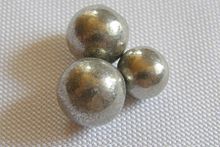Mond process

The Mond process, sometimes known as the carbonyl process is a technique created by Ludwig Mond in 1890[1] to extract and purify nickel. The process was used commercially before the end of the 19th century.[2] It is done by converting nickel oxides (nickel combined with oxygen) into pure nickel.
This process makes use of the fact that carbon monoxide complexes with nickel readily and reversibly to give nickel carbonyl. No other element forms a carbonyl compound under the mild conditions used in the process.
This process has three steps:
1. Nickel oxide is reacted with Syngas at 200 °C to remove oxygen, leaving impure nickel. Impurities include iron and cobalt.
- NiO (s) + H2 (g) → Ni (s) + H2O (g)
2. The impure nickel is reacted with excess carbon monoxide at 50–60 °C to form nickel carbonyl.
- Ni (s) + 4 CO (g) → Ni(CO)4 (g)
3. The mixture of excess carbon monoxide and nickel carbonyl is heated to 220–250 °C. On heating, nickel tetracarbonyl decomposes to give nickel:
- Ni(CO)4 (g) → Ni (s) + 4 CO (g)
The decomposition may be engineered to produce powder, but more commonly an existing substrate is coated with nickel. For example, nickel pellets are made by dropping small, hot pellets through the carbonyl gas; this deposits a layer of nickel onto the pellets.
This process has also been used for plating nickel onto other metals, where a complex shape or sharp corners made good results difficult by electroplating. Although the results are good, the toxicity makes it impractical as an industrial process. Such parts are now plated by electroless nickel plating instead.
See also
References
- ^ Mond, Ludwig; Langer, Carl; Quincke, Friedrich (1890). "Action of Carbon Monoxide on Nickel". J. Chem. Soc., Trans. 57: 749–753. doi:10.1039/CT8905700749.
- ^ "The Extraction of Nickel from its Ores by the Mond Process". Nature. 59 (1516): 63–64. 1898. doi:10.1038/059063a0.
- Webelements.
- Liptrot GF (1983) Modern Inorganic Chemistry 4th ed p386 Unwin Hyman
- Pauling, L (1964) College chemistry 3rd ed p658 Freeman
- Rawcliffe, CT & Rawson, DH (1974) Principles of inorganic and theoretical chemistry 2nd ed p409 Heinemann
- [1]
- "Nickel Chemistry" from the University of the West Indies (Mona)
